From Wikipedia [Emphasis Added] The Chronicles of Narnia is a series of seven fantasy novels for children written by C. S. Lewis. It is considered a classic of children's literature and is the author's best-known work, having sold over 100 million copies in 41 languages. Written by Lewis between 1949 and 1954 and illustrated by Pauline Baynes, The Chronicles of Narnia have been adapted several times, complete or in part, for radio, television, stage, and cinema. The order in which they were first published was The Lion, the Witch and the Wardrobe, Prince Caspian, The Voyage of the Dawn, The Silver Chair, The Horse and His Boy, The Magician's Nephew and The Last Battle. A film version of the first book, called The Chronicles of Narnia: The Lion, the Witch and the Wardrobe, was released in December 2005 and achieved critical and box-office success, reaching the Top 25 (by revenue) of all films released until that time. The Chronicles of Narnia: Prince Caspian was subsequently released on May 16, 2008. It is said that Disney plans to make all seven of the books into movies with the third, The Voyage of the Dawn Treader, already in production.
The Lion, the Witch and the Wardrobe tells the story of four ordinary children: Peter, Susan, Edmund, and Lucy Pevensie, who during the World War II, are sent away for safekeeping into the English countryside to stay with an old professor until danger subsides at their home in London. During their stay they discover that a wardrobe in the professor’s house leads to the magical land of Narnia (a parallel universe) which is currently under the spell of a witch. The four children fulfill an ancient, mysterious prophecy, which says that two sons of Adam and two daughters of Eve will come to challenge the curse of the evil White Witch, who has reigned over the kingdom of Narnia, keeping it in winter for 100 years. The Pevensie children help the lion Aslan and his army save Narnia from eternal winter Prince Caspian: The Return to Narnia continues the story with the Pevensie children's second trip to Narnia and their once again aiding Prince Caspian with the help of Aslan) who has been removed from the throne.
The first "Narnia" movie was much discussed in terms of C.S. Lewis's Christian symbolism. While C.S. Lewis himself said that his book was not a “Christian” book, many Christians have seen in them parallels to Jesus and the Gospel. Lewis himself said “At first there wasn’t anything Christian about them; that element pushed itself in of its own accord”. However, the Christian theme seems to be more of an undercurrent than a primary consideration and, unless their parents have taken the trouble to explain the spiritual aspects to them, it is likely to sail over the heads of most children. ChristianAnswers.Net says the following about the first movie The Lion, the Witch and the Wardrobe A wonderful adventure. An illustrious biblical metaphor. A beautiful Christmas story. A captivating fantasy. From the very heart of renowned Christian apologetic C.S. Lewis is the story of four children… Lucy introduces her brothers and sister to a realm of make-believe that is more fun than any fantasy and more real than life and death. It is a world that provides friends and enemies, battles and betrayals, family unity and sacrifice, and a promise to become a king or queen. [1]
While www.gotquestions.org says While it is true that the Chronicles of Narnia series includes evil witches and mystical spells, every book is filled with Biblical allegory and allusions. For instance, the hero of the "The Lion, the Witch, and the Wardrobe" is a lion named Aslan (Jesus is called a lion in Revelation 5:5). Aslan created the world of Narnia with his voice which is very similar to the Genesis account of how God created the earth - "and God said, 'Let there be light'" (Genesis 1:3). In addition, Aslan dies in the place of a sinner, rises from the dead, and by doing so, defeats an age-old curse. Redemption is bestowed upon Narnia because of the death and resurrection of Aslan. [2]
Plugged In online [a registered trademark of Focus on the Family] gives us a “primer on Narnian allegory”: Aslan serves the Emperor Beyond the Sea (God the Father) and yet is also creator of Narnia (compare Colossians 1:16). Even though Aslan clearly has power over the White Witch, he chooses to work through human beings to accomplish his will to free Narnia. And he offers his own innocent blood to pay for Edmund's sin (Romans 5:8). His "Gethsemane" is a forest glade. His "disciples" are Susan and Lucy. As he is led to the Stone Table to be killed, he is mocked and humiliated by the White Witch's evil cohort yet does not protest or fight back (read Isaiah 53:4-7 and the gospel accounts of Christ's scourging and crucifixion). Most important, he rises from the dead and the atonement is complete (Colossians 1:13-14). Aslan tells Edmund's siblings not to bring up their brother's betrayal again: "What's done is done," he explains (Psalm 103:12; 2 Corinthians 5:17 and Hebrews 10:17). As he presents Edmund to the court at the castle Cair Paravel, he calls him "Edmund the Just" (see Romans 5:19). [3]
The Other Side
But, in spite of the arguably traditional Christian themes, the Chronicles of Narnia draw as much from pagan mythology as it does the Bible. The magical world of Narnia is inhabited almost exclusively by minotaurs, centaurs and unicorns. Satyrs, fauns, and nymphs cavort among the pages accompanied by cyclopes, dwarfs, griffins and giants. Add tree-spirits and river-gods to this curious mixture and you have quite a wide spectrum of mythological creatures derived from Greek, Roman and Norse mythology. For example Centaurs originated in Greek myth, and dwarfs have origins in Norse myth.
All of which does not trouble me unduly. However there are a couple of areas which do. While I understand that C.S. Lewis did not set out to write a ‘Christian Book’. When the Christian “element pushed itself in of its own accord”, he did not modify some of the characters [in particular the Greek god Bacchus, the Maenads and Mr. Tumnus], not only allowing them to peacefully co-exist with Aslan (The figure of Christ), but actually portraying them in a positive light. In ascending order of ‘seriousness’
River-god
The book contains and account of an animistic "River god" [Emphasis Added]
They turned a little to the right, raced down a steep hill and found the long bridge of Beruna in front of them. Before they had begun to cross it, however, up out of the water came a great wet bearded head, larger than an man's, crowned with rushes. It looked at Aslan and out of it's mouth a deep voice came. "Hail, Lord" it said. "loose my chains"
"Who on earth is that?" whispered Susan.
"I think it's the river-god, but hush" said Lucy. "Bacchus" said Aslan. "Deliver him from his chains.” [Page 407]
Silenus
In one scene Lucy whispers to Susan... The boy with the wild face is Bacchus and the old one on the donkey is Silenus. Don't you remember Mr Tumnus telling us about them long ago?"
To which Susan replies that she does remember, but that she would not have "felt safe with Bacchus and all his wild girls" if they had met them without Aslan". [Page 389. Emphasis Added]. So who is Silenus? According to the Encyclopedia Mythica.. “Originally plural (Sileni), but later mentioned as one Silenus, the teacher and faithful companion of the wine-god Dionysus. A notorious consumer of wine, he is usually totally drunk and is supported by satyrs or carried by a donkey. When the Phrygian king Midas took the drunk Silenus in his house, Dionysus handsomely reward Midas for his hospitality. He has much wisdom and if captured by mortals he can reveal important secrets. Silenus is usually portrayed as a plump jovial old man with a long beard and stump nose, bald and with a horse's tail”. [4]
Bacchus
The book describes a scene that most people would not associate with the mysteries of the Greek god Dionysius.. yet it does that and more... “The crowd and dance round Aslan (for it had become a dance once more) grew so thick and rapid that Lucy was confused. She never saw where certain other people came from who were soon capering among the trees. One was a youth, dressed only in a fawn skin, with vine leaves wreathed in his curly hair. His face would have been almost too pretty for a boy’s, if it had not looked so extremely wild. You felt, as Edmund said when he saw him a few days later, ‘There’s a chap who might do anything, absolutely anything.’ He seemed to have a great many names – Bromios, Bassareus, and the Ram were three of them. There were a lot of girls with him, as wild as he. There was even, unexpectedly, someone on a donkey. And everybody was laughing: and everyone was shouting out, ‘EUAN, EUAN, EU-oi-oi-oi.’ [The Chronicles of Narnia. Page 388. 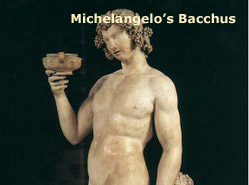 Emphasis Added]. Emphasis Added].
Bassareus is a surname of Dionysus who, on the one hand, was as the Greek god of wine, agriculture, and fertility of nature, but on the other hand represents the outstanding features of mystery religions... ecstasy, personal delivery from the daily world through physical or spiritual intoxication, and initiation into secret rites. Dionysus, was also commonly known by his Roman name Bacchus Bassareus is derived from bassara or bassaris, the long robe which the god himself and the Maenads used to wear in Thrace. The Maenads themselves are often called Bassarae or Bassarides”. [5] The mysteries of the Greek god Dionysius, were celebrated with orgiastic rituals and drunkenness. His Roman counterpart Bacchus was worshipped by women with wild and excessive behavior. The origins of the festival of Mardi Gras, marked by several days of partying, parading, chaos, and most importantly… drinking, is often attributed to the Festival of Dionysus in Greece, since the three groups that followed him, the Sileni, Satyrs, and Maenads, indulge in exuberant drunken binges that often got violent..
The Maenads
In Narnia, the Maenads, portrayed as wild, rambunctious young girls are called Bacchus’ “fierce madcap girls”.
“Then the whole party moved off – Aslan leading. Bacchus and his Maenads leaping, rushing and turning somersaults, the beasts brushing round them, and Silenus and his donkey bringing up the rear. [The Chronicles of Narnia. Page 407. Emphasis Added]
In Greek mythology, Maenads were the inspired and frenzied female worshippers of Dionysus, the Greek god of mystery, wine, and intoxication… the Roman god Bacchus. Their name literally translates as "raving ones". The Chronicles of Narnia pictures a scene where the Maenads dance with Silenus and Bacchus. Then three or four Red Dwarfs came forward with their tinder boxes and set light to the pile, which first crackled, and then blazed, and finally roared as a woodland bonfire on midsummer night ought to do. And every-one sat down in a wide circle around it. Then Bacchus and Silenus and the Maenads began a dance, far wilder than the dance of the trees, not merely a dance for fun and beauty (though it was that too), but a magic dance of plenty, and where their hands touched, and where their feet fell, the feast came into existence. Sides of roasted meat that filled the grove with delicious smell, and wheaten cakes and oaten cakes…” [The Chronicles of Narnia. Pages 413-414. Emphasis Added]
Which is an extremely sanitized version of what the Maenads were really about… They were known as wild, insane women who could not be reasoned with. The mysteries of Dionysus inspired the women to ecstatic frenzy; they indulged in copious amounts of violence, bloodletting, sexual activity, self-intoxication, and mutilation. They were usually pictured as crowned with vine leaves, clothed in fawn skins and carrying the thyrsus, and dancing with wild abandon…. In Greek vase-painting, the frolicking of Maenads and Dionysus is often a theme depicted on Greek kraters, used to mix water and wine. These scenes show the Maenads in their frenzy running in the forests, often tearing to pieces any animal they happen to come across. [Wikipedia] “For the mystically inclined, maenadism gave women a chance to touch the divine. "The bacchante pays no attention to the silenus who grabs at her in his lust," Otto quotes Plutarch; "the image of Dionysos, whom she loves, stands alive before her soul, and she sees him even though he is far away from her; for the glances of the bacchante sweep up high into the aether and yet are filled with the spirit of love." Her state of frenzy is blessed. She goes beyond the intoxication of wine, the characteristic maenad dance with thrown-back head of vase paintings, to the pure madness and ecstasy of a spirit wedding [to] the god. The core ritual associated with the worship of Dionysus among the Greeks was orgiastic, meaning that it involved states of trance-like ecstasy, “outside-of-one selfness,” merging with and possession by the god. It was celebrated every two years, at mid-winter near the time of the solstice, on barren mountain tops, especially Mt. Parnassus overlooking Delphi…. [6]
Also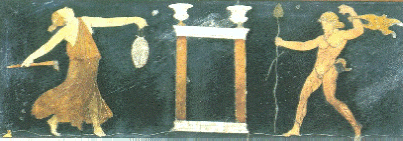 “In depictions of Mænads on 28 of the existent Mænadic vase paintings, the heads of the women show a strong backward bend. The same is true of entranced voodoo dancers, which one researcher has described as 'their heads are thrown weirdly back as if their necks were broken.' [7]
Lets go back to Page 388.. the depiction of the dance around Aslan, the supposed Christ figure.. There were a lot of girls with him, as wild as he. There was even, unexpectedly, someone on a donkey. And everybody was laughing: and everyone was shouting out, ‘EUAN, EUAN, EU-oi-oi-oi.’ [Page 388. [Emphasis Added].
The ancient rites were described by Greek writers such as Euripides who referred to the followers of Dionysus as the "Bacchants of Hades". Euoi was the ecstatic cry of the Bacchantes "Following the torches as they dipped and swayed in the darkness, they climbed mountain paths with head thrown back and eyes glazed, dancing to the beat of the drum which stirred their blood' [or 'staggered drunkenly with what was known as the Dionysos gait']. 'In this state of ekstasis or enthusiasmos, they abandoned themselves, dancing wildly and shouting 'Euoi!' [the god's name] and at that moment of intense rapture became identified with the god himself. They became filled with his spirit and acquired divine powers" [8].
Which brings us to yet another character... Mr. Tumnus. This is especially concerning since C.S. Lewis said that the first Narnia story, The Lion, the Witch and the Wardrobe, came to him from a single picture he had in his head of a fawn carrying an umbrella and parcels through a snowy wood. In other words, Tumnus was the initial inspiration for all of the Narnia stories. Mr. Tumnus
Tumnus described by Lewis as having reddish skin, curly hair, a short pointed beard, horns on his forehead,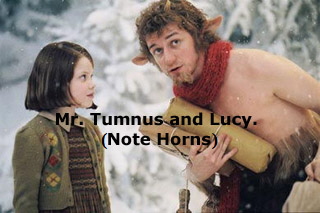 cloven hooves, shiny black goat legs, and a long goat's tail, is featured prominently in The Lion, the Witch and the Wardrobe, being the first person Lucy meets in Narnia. He makes his appearance again in The Horse and His Boy and The Last Battle. cloven hooves, shiny black goat legs, and a long goat's tail, is featured prominently in The Lion, the Witch and the Wardrobe, being the first person Lucy meets in Narnia. He makes his appearance again in The Horse and His Boy and The Last Battle. Unfortunately Mr. Tumnus bears an disconcerting similarity to the Greco/Roman fertility deity Pan, usually represented as a satyr - a creature half-man and half-goat. Nor do the similarities end there. Mr. Tumnus plays a flute, Pan is known for his trademark pipes. Both live in the forest and party at night. 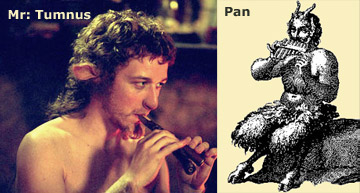 In Roman mythology, Pan and his counterpart Faunus were both Horned God deities. Pan, from which we get the word panic, is popular among many Neo-pagans and occult groups. He has the hindquarters, legs, and horns of a goat and is recognized as the god of fields, groves, and wooded glens and is connected to fertility and season of spring. Ever-lecherous, this god known for his unquenchable sex drive and fearful presence ,was involved in numerous love affairs with the “nymphs,” especially Echo, Syrinx, and Pithys. Worshipers of Pan were known for their wild parties. In Roman mythology, Pan and his counterpart Faunus were both Horned God deities. Pan, from which we get the word panic, is popular among many Neo-pagans and occult groups. He has the hindquarters, legs, and horns of a goat and is recognized as the god of fields, groves, and wooded glens and is connected to fertility and season of spring. Ever-lecherous, this god known for his unquenchable sex drive and fearful presence ,was involved in numerous love affairs with the “nymphs,” especially Echo, Syrinx, and Pithys. Worshipers of Pan were known for their wild parties.
Note the words of the 1929 Hymn to Pan by Satanist Aleister Crowley [Emphasis Added] “I rave; and I rape and I rip and I rend Everlasting world without end! Mannikin, maiden, maenad, man, In the might of Pan.”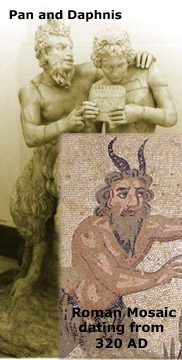
It is common knowledge that Pan and Herne are popular names for Satan. Page 144 of Anton Szandor LaVey’s The Satanic Bible lists Pan as one of the Infernal Names of Satan. Most witches experience, believe in, invoke, or worship the Mother or "triple Goddess" and her male consort, the Horned God. Practitioners of Witchcraft celebrate four ceremonies to honor the Green Goddess, who brings life, and the Horned God, consort of the Goddess, who brings death. The popular depictions of Satan are derived, however incorrectly, from mythological sources. Half human and half goat, Pan remains one of the most enduring and compelling symbols for the anti-Christ. The significance of the symbolism of the goat comes from Matthew 25:33, 41.. "And He will set the sheep on His right hand, but the goats on the left." v. 33 "Then He will also say to those on the left hand, 'Depart from Me, you cursed, into the everlasting fire prepared for the devil and his angels . . ." vs. 41
A short time before His crucifixion Jesus brought the disciples to Caesarea Philippi, which is not somewhere you get to by accident. From ancient times the place was the site of worship of pagan nature gods, first Ba'al & then Pan, notorious for it’s evil practices and atrociously immoral pagan rites. It was here that Jesus told His disciples that “upon this rock I will build my church; and the gates of hell shall not prevail against it”. The rock He was referring to was the cliff where people had carved niches for their idols. The shrines to Ba’al and Pan were the ‘gates of hell’. [Read Article] As an aside .. In the remote mountains of Morocco there's a group that still practices, in a literal sense, the Rites of Pan. "The Master Musicians of Joujouka", as they are called, inhabit a mystical world where music is the key that unlocks the supernatural. Brian Jones Presents the Pipes of Pan at Joujouka, was a 1968 album produced by Brian Jones of the Rolling Stones. The album was a recording of the Moroccan group the Master Musicians of Joujouka, in performance in their village, Jajouka [spelled "Joujouka" on the original album]. Jones called the tracks "a specially chosen representation" of music played in the village during the annual week-long Rites of Pan Festival, described by rock artist and writer, Robert Palmer, in his article in Rolling Stone Magazine, "When the music and energy were at their height, the tribesmen milled in ecstatic trances, their eyes rolled back in their heads, screaming like a great rending of the heavens.... Pan himself was there. Several times I witnessed the instant when the current began to surge in earnest and coursed through the quivering frame of a local shepherd... When the power came down, the shepherd suddenly wasn't there and Someone Else was looking out of eyes that abruptly began to glow like ruby lasers. One night he came and jerked me out of the crowd, and I ran with him. He leaped through a bonfire, and then I was in the bonfire, surrounded by flames but unharmed. Then I was spinning like a top, spinning into darkness. 'We have seen you through the music,' they (the Pan-worshipers) told me, 'Now you are one of us.'" [9].
Conclusion
Films like Narnia in which Pan appears friendly and even benign are doing their bit to changing the historically mythical Pan’s notorious reputation. In the words of Ruthanne Prioreschi in Hercules, Narnia, and Pan’s Labyrinth
“Media depictions of the mythical creature Pan has illustrated the creature benevolently despite his sexually horrific past… The positive image of Pan is a definitive example of how the media powerfully encrypts and shapes perceptions of even the most offensive creature”.
And while the media is entitled to portray Pan in a positive light, and C.S. Lewis was entitled to write whatever he wanted, it is mind boggling how Christians can once again be fooled. Since the story bears some resemblance to the Gospel inasmuch as Aslan created Narnia, chose to work through human beings to accomplish his will, offered his own innocent blood and rose from the dead, Christians have all but ignored the serious element insidiously introduced... the blurring of the distinction between good and evil. Aslan frolics with characters like Bacchus, the Maenads and the mirror image of Pan, all of whom Jesus would have had nothing to do with, but would have cast out. While on the one hand the white witch, a fantasy character, is portrayed as evil, the other, far more dangerous, creatures based on ancient mythology and depictions of Satan himself peacefully co-exist with Aslan in tolerance, mutual respect and cooperation. Call The Chronicles of Narnia a fantasy adventure. Call it a classic of children's literature, if you must. But please DO NOT call it a Christian allegory.
EndNotes
[1] www.christiananswers.net/spotlight/movies/2005/
thechroniclesofnarniathelionthewitchandthewardrobe2005.html
[2] www.gotquestions.org/Chronicles-of-Narnia.html [3] www.pluggedinonline.com/movies/movies/a0002447.cfm [4] www.pantheon.org/articles/s/silenus.html [5] Greek Myth Index http://www.ancientlibrary.com/smith-bio/0479.html [6] http://www.carnaval.com/maenads/ Emphasis Added [7] M. Isidora Forrest. Notes on the Mænads and Ecstatic Dance.
http://www.hermeticfellowship.org/Dionysion/Maenads.html [8] Peter Hoyle, Delphi (London: 1967), p. 76. As quoted in Mardi Gras & Carnival Goers Feel Call Of Ancient Deity? By Thomas R. Horn. Emphasis Added [9] Rolling Stone Magazine, March 23, 1989, p. 106 |